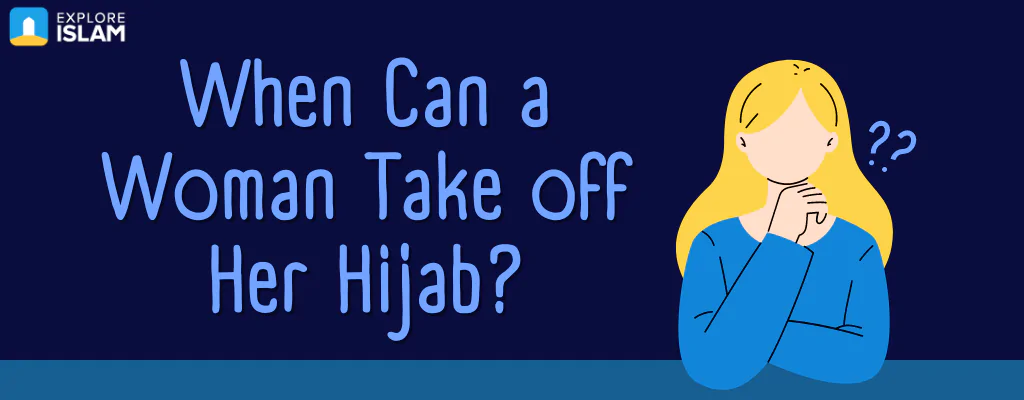Islam has honored women and established many controls that ensure their protection and preservation from any harm, among which donning the Hijab.
Hijab is not a brand new concept that is exclusive to Islam. However, in Islam, women have to wear Hijab, the modest clothing that women wear to cover their whole body, except the face and the palm of the hands, upon reaching puberty. They must put it in front of all Non-Mahram men (who are not immediate family members and to whom marriage is permissible.)
Here we will learn the following:
However, Muslim women do not wear Hijab 24-7. They are allowed to take off their Hijab at many times, for example:
- During everyday activities at home, like chores, cooking, … etc. as long as no Non-Mahram men are present.
- During females-only gatherings or parties, the Muslim woman has the freedom to remove her Hijab when interacting with other women.
- During official procedures, such as medical examinations or government verification, Muslim women can temporarily take off their Hijab if necessary.
- During an emergency situation, where her life or the life of another is at risk. However, once the emergency passes, she must put her hijab back on.
Who Can See a Woman Without a Hijab
Women are allowed to take off their Hijab in front of their husbands, for sure, and in front of men who are their Mahrams (to whom marriage is prohibited forever).
1) Mahrams by ties of blood (kinship)
- Fathers, grandfathers, great grandfathers, and all their ancestors, both maternal and paternal, regardless of the generational gap, are considered mahrams.
- Sons, grandsons, great-grandsons, and all their descendants.
- Siblings (Including step brothers; shared parentage establishes the mahram relationship)
- Nieces and nephews on the maternal and paternal sides.
- Maternal and paternal uncles (referring to the brothers of your mother, not the husbands of your aunts)
2) Mahrams by breastfeeding
- Those who were nursed alongside the woman during infancy.
- Fathers, uncles, brothers, nieces, and nephews of the woman’s foster sibling, as in Islam, foster relations are treated like blood relations (in marital affairs)
3) Mahrams by marriage
- Fathers-in-law and their ancestors
- Stepsons and their descendants
- Stepfather
- Son-in-law
Moreover, women are allowed to take off their Hijab in front of:
- Prepubescent boys
In front of the abovementioned men, the woman can take off her headscarf and can show her hair, neck, arms, and feet. It is not preferable to reveal more or wear tight clothes, except in front of her husband.
ًMahrams of Woman in The Holy Qur’an
Allah The Almighty stated who can see the woman without her Hijab in the Holy Qur’an saying:
“And tell the believing women to reduce [some] of their vision and guard their private parts and not expose their adornment except that which [necessarily] appears thereof and to wrap [a portion of] their head covers over their chests and not expose their adornment except to their husbands, their fathers, their husbands’ fathers, their sons, their husbands’ sons, their brothers, their brothers’ sons, their sisters’ sons, their women, that which their right hands possess, or those male attendants having no physical desire, or children who are not yet aware of the private aspects of women.”
[Quran 24/31]
Who Can Not See a Woman Without a Hijab
All the Non-Mahram men (to whom the woman can get married) are not allowed to see the woman without her Hijab.
In The Holy Qur’an, Allah orders Prophet Muhammad (Peace Be Upon Him) to ask all Muslim women to cover their whole bodies, including their hair, whenever going out of their houses or whenever there are Non- Mahram men surrounding them so that they are not harassed.
Some Non-Mahram Relationships for Women That People Sometimes Confuse
The woman must wear her full Hijab in front of:
- Brother-in-law
- Husband of your father’s sister
- Husband of your mother’s sister
- Your aunt’s husband
- Male cousins
Evidence from the Holy Qur’an that women must veil themselves and hide their charms from Non-Mahrams
Allah says: “O Prophet! Ask your wives, daughters, and believing women to draw their cloaks over their bodies. In this way it is more likely that they will be recognized ˹as virtuous˺ and not be harassed. And Allah is All-Forgiving, Most Merciful.”
(Qur’an. 33:59)
Allah also says “O Prophet!˺ Tell the believing men to lower their gaze and guard their chastity. That is purer for them. Surely Allah is All-Aware of what they do. And tell the believing women to lower their gaze and guard their chastity, and not to reveal their adornments except what normally appears. Let them draw their veils over their chests,…”
(Qur’an. 31:24)
*Most of the scholars see that what is meant by “except what normally appears” are the woman’s face and palms of the hands; these are the only parts the woman can show in front of men.
In conclusion, Islam mandates the wearing of Hijab for all Muslim women not to oppress them but to safeguard their well-being and shield them from harmful gazes. Islam regards women with utmost respect, akin to queens whose dignity should be preserved and who should not be easily accessible to anyone.
If you need any clarification about Hijab, please contact us and Insha’Allah we will help you get a better understanding.

